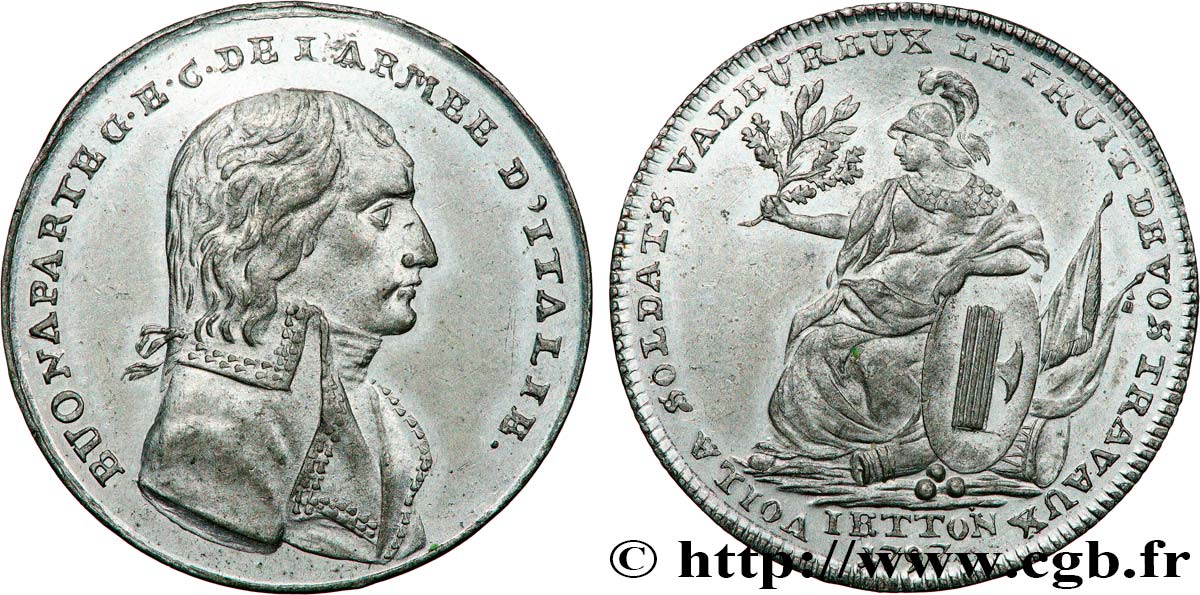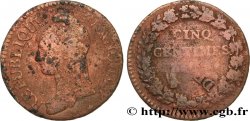fjt_907506 - DIREKTORIUM Bonaparte - Première campagne d’Italie 1797
Menge
In den Warenkorb

Type : Bonaparte - Première campagne d’Italie
Datum: An 6 (1797-1798)
Metall : Weissmetall
Durchmesser : 32 mm
Stempelstellung : 12 h.
Gewicht : 11,50 g.
Rand Lisse
Seltenheitsgrad : INÉDIT
Kommentare zum Erhaltungszustand:
Magnifique exemplaire !
N° im Nachschlagewerk :
Vorderseite
Titulatur der Vorderseite BUONAPARTE G. E. C. DE LA BRAVE ARMEE D'ITALIE.
Beschreibung Vorderseite Buste de Napoléon à droite ; les deux revers de l’habit brodé sont ouverts.
Rückseite
Titulatur der Rückseite VOILA SOLDATS VALEUREUX LE FRUIT DE VOS TRAVAUX ; À L'EXERGUE : IETTON 1797.
Beschreibung Rückseite Minerve assise à gauche sur un trophée d'armes, tenant de la main droite une branche de laurier, appuyé sur un bouclier orné.
Kommentare
Type non mentionné par Hennin. Manque au Hennin !
Général en manteau avec habits ouverts.
La première campagne d'Italie (1796-1797) peut être considérée comme début d'une carrière militaire et politique spectaculaire d'un officier qui, à ce moment, était encore
inconnu. Napoléon est envoyé à Nice le 11 mars 1796 pour diriger une armée vers l’est pour conquérir l'Italie. Ce pays était occupé par l'Autriche, qui était à cette époque, le grand rival politique et militaire de la France et qui avait formé, avec la Prusse et l'Angleterre, une coalition internationale dans le but de renverser le régime français et ainsi mettre fin à la Révolution française.
À son arrivée à Nice le 27 mars, Napoléon rencontre une armée sous-payée et mal équipée. À l’âge de 27 ans, il était également beaucoup plus jeune que les généraux qui commandaient les différentes unités de l’armée sous ses ordres. Mais lorsque le “général et chef” ouvrit la bouche, tout le monde écouta ce qu’il disait. Au cours de son discours souvent cité, Napoléon comprit le mécontentement de ses soldats et promit de leur donner gloire et richesse dans le nord de l'Italie.
Sa stratégie militaire pour affronter un ennemi beaucoup plus fort est toujours considérée comme un exemple de tactique brillante. Il concentra ses forces sur un point et sépara deux grandes armées (l'armée de Lombardie/Sardaigne et l’armée d’Autriche, chacune plus forte que la sienne). En Lombardie, il s'en prit ensuite avec une vitesse incroyable à l’armée sarde, qu'il vainquit sans problème. Il conclut un traité de paix et partit ensuite en guerre contre les Autrichiens, qu'il chassa d'Italie en 1797.
À ce jeune âge, Napoléon réalisa qu'en tant que héros de la bataille et sauveur de la Révolution française, il pouvait faire plus pour son pays. Alors, à l'automne 1796, il développa le début des ambitions politiques à Milan. Comme outil de propagande pour diffuser plus largement son nom et sa renommée, il fit fabriquer un certain nombre (peut-être des milliers) de pièces en cuivre, en laiton ou en étain qui montrent son portrait et son titre comme général-en-chef de l’Armée d’Italie. Ces pièces sont trop grandes pour être des jetons typiques, et il est peu probable qu'ils aient été fabriqués pour servir de jetons de comptage dans une chambre financière. Il est plutôt probable qu’ils aient servi à être un souvenir pour ses troupes d’une campagne militaire très réussie. Bien sûr, au revers, Napoléon s'adresse à ses soldats directement et leur rappelle son discours de Nice : “Faites-moi confiance, suivez-moi et je vous récompenserai avec la gloire et la richesse”.
Plus d’information: Bulletin Numismatique n°228, pages 28-30 (2023) et Bulletin Numismatique n°234, pages 45-47 (2024).
Type not mentioned by Hennin. Hennin is missing! General in a coat with open clothes.
The first Italian campaign (1796-1797) can be considered as the beginning of a spectacular military and political career of an officer who, at that time, was still unknown.. Napoleon was sent to Nice on March 11, 1796, to lead an army east to conquer Italy.. This country was occupied by Austria, which was at that time the great political and military rival of France and which had formed, with Prussia and England, an international coalition with the aim of overthrowing the French regime and thus putting an end to the French Revolution..
Upon his arrival in Nice on March 27, Napoleon encountered an underpaid and poorly equipped army.. At the age of 27, he was also much younger than the generals who commanded the various army units under him.. But when the “general and leader” opened his mouth, everyone listened to what he said.. In his often-quoted speech, Napoleon understood his soldiers' discontent and promised to give them glory and wealth in northern Italy..
His military strategy to confront a much stronger enemy is still considered an example of brilliant tactics. He concentrated his forces on one point and separated two large armies (the Army of Lombardy/Sardinia and the Army of Austria, each stronger than his own). In Lombardy, he then attacked the Sardinian army with incredible speed, which he defeated without difficulty.. He concluded a peace treaty and then went to war against the Austrians, whom he drove out of Italy in 1797..
At this young age, Napoleon realized that as a hero of battle and savior of the French Revolution, he could do more for his country. So, in the autumn of 1796, he developed the beginning of political ambitions in Milan. As a propaganda tool to spread his name and fame more widely, he had a number (perhaps thousands) of copper, brass or tin coins made which show his portrait and his title as General-in-Chief of the Army of Italy. These coins are too large to be typical tokens, and it is unlikely that they were made to serve as counting tokens in a financial chamber.. It is rather likely that they served as a souvenir for his troops of a very successful military campaign. Of course, on the reverse, Napoleon addresses his soldiers directly and reminds them of his speech at Nice: “Trust me, follow me and I will reward you with glory and riches.”.
More information: Numismatic Bulletin No. 228, pages 28-30 (2023) and Numismatic Bulletin No. 234, pages 45-47 (2024)
Général en manteau avec habits ouverts.
La première campagne d'Italie (1796-1797) peut être considérée comme début d'une carrière militaire et politique spectaculaire d'un officier qui, à ce moment, était encore
inconnu. Napoléon est envoyé à Nice le 11 mars 1796 pour diriger une armée vers l’est pour conquérir l'Italie. Ce pays était occupé par l'Autriche, qui était à cette époque, le grand rival politique et militaire de la France et qui avait formé, avec la Prusse et l'Angleterre, une coalition internationale dans le but de renverser le régime français et ainsi mettre fin à la Révolution française.
À son arrivée à Nice le 27 mars, Napoléon rencontre une armée sous-payée et mal équipée. À l’âge de 27 ans, il était également beaucoup plus jeune que les généraux qui commandaient les différentes unités de l’armée sous ses ordres. Mais lorsque le “général et chef” ouvrit la bouche, tout le monde écouta ce qu’il disait. Au cours de son discours souvent cité, Napoléon comprit le mécontentement de ses soldats et promit de leur donner gloire et richesse dans le nord de l'Italie.
Sa stratégie militaire pour affronter un ennemi beaucoup plus fort est toujours considérée comme un exemple de tactique brillante. Il concentra ses forces sur un point et sépara deux grandes armées (l'armée de Lombardie/Sardaigne et l’armée d’Autriche, chacune plus forte que la sienne). En Lombardie, il s'en prit ensuite avec une vitesse incroyable à l’armée sarde, qu'il vainquit sans problème. Il conclut un traité de paix et partit ensuite en guerre contre les Autrichiens, qu'il chassa d'Italie en 1797.
À ce jeune âge, Napoléon réalisa qu'en tant que héros de la bataille et sauveur de la Révolution française, il pouvait faire plus pour son pays. Alors, à l'automne 1796, il développa le début des ambitions politiques à Milan. Comme outil de propagande pour diffuser plus largement son nom et sa renommée, il fit fabriquer un certain nombre (peut-être des milliers) de pièces en cuivre, en laiton ou en étain qui montrent son portrait et son titre comme général-en-chef de l’Armée d’Italie. Ces pièces sont trop grandes pour être des jetons typiques, et il est peu probable qu'ils aient été fabriqués pour servir de jetons de comptage dans une chambre financière. Il est plutôt probable qu’ils aient servi à être un souvenir pour ses troupes d’une campagne militaire très réussie. Bien sûr, au revers, Napoléon s'adresse à ses soldats directement et leur rappelle son discours de Nice : “Faites-moi confiance, suivez-moi et je vous récompenserai avec la gloire et la richesse”.
Plus d’information: Bulletin Numismatique n°228, pages 28-30 (2023) et Bulletin Numismatique n°234, pages 45-47 (2024).
Type not mentioned by Hennin. Hennin is missing! General in a coat with open clothes.
The first Italian campaign (1796-1797) can be considered as the beginning of a spectacular military and political career of an officer who, at that time, was still unknown.. Napoleon was sent to Nice on March 11, 1796, to lead an army east to conquer Italy.. This country was occupied by Austria, which was at that time the great political and military rival of France and which had formed, with Prussia and England, an international coalition with the aim of overthrowing the French regime and thus putting an end to the French Revolution..
Upon his arrival in Nice on March 27, Napoleon encountered an underpaid and poorly equipped army.. At the age of 27, he was also much younger than the generals who commanded the various army units under him.. But when the “general and leader” opened his mouth, everyone listened to what he said.. In his often-quoted speech, Napoleon understood his soldiers' discontent and promised to give them glory and wealth in northern Italy..
His military strategy to confront a much stronger enemy is still considered an example of brilliant tactics. He concentrated his forces on one point and separated two large armies (the Army of Lombardy/Sardinia and the Army of Austria, each stronger than his own). In Lombardy, he then attacked the Sardinian army with incredible speed, which he defeated without difficulty.. He concluded a peace treaty and then went to war against the Austrians, whom he drove out of Italy in 1797..
At this young age, Napoleon realized that as a hero of battle and savior of the French Revolution, he could do more for his country. So, in the autumn of 1796, he developed the beginning of political ambitions in Milan. As a propaganda tool to spread his name and fame more widely, he had a number (perhaps thousands) of copper, brass or tin coins made which show his portrait and his title as General-in-Chief of the Army of Italy. These coins are too large to be typical tokens, and it is unlikely that they were made to serve as counting tokens in a financial chamber.. It is rather likely that they served as a souvenir for his troops of a very successful military campaign. Of course, on the reverse, Napoleon addresses his soldiers directly and reminds them of his speech at Nice: “Trust me, follow me and I will reward you with glory and riches.”.
More information: Numismatic Bulletin No. 228, pages 28-30 (2023) and Numismatic Bulletin No. 234, pages 45-47 (2024)








 Berichten über einen Fehler
Berichten über einen Fehler Die Seite drucken
Die Seite drucken Teilen meiner Auswahl
Teilen meiner Auswahl Stellen Sie eine Frage
Stellen Sie eine Frage Einlieferung/Verkauf
Einlieferung/Verkauf
 Details
Details










